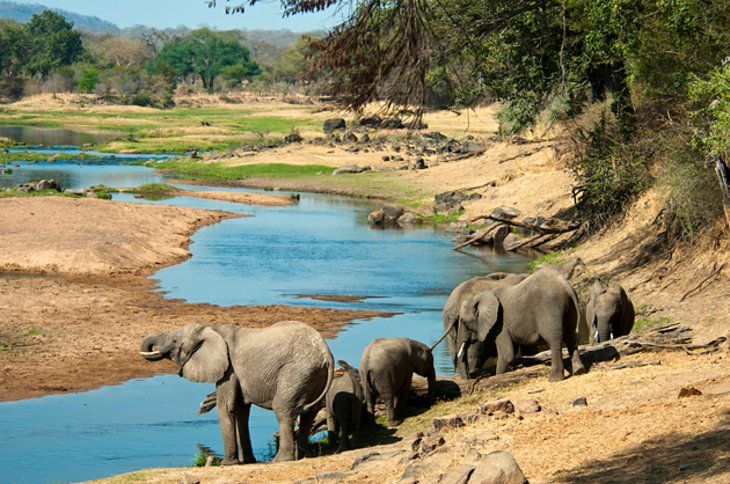Attractions in Tanzania
Tanzania is one of Africa’s most remarkable destinations, offering stunning natural beauty, unique wildlife, and a rich cultural heritage. Here’s an overview of the top attractions that make Tanzania a must-visit for travelers. Attractions in Tanzania
Key Attractions in Tanzania
1. Mount Kilimanjaro
- Known as the “Roof of Africa,” Mount Kilimanjaro is the highest peak on the continent at 5,895 meters (19,341 feet). The dormant volcano, crowned with snow despite being near the equator, offers climbers a thrilling adventure and panoramic views from Uhuru Peak. It’s popular for both climbers and those who come to admire its majestic silhouette from below.
2. Serengeti National Park
- Famous worldwide for the Great Wildebeest Migration, Serengeti National Park is one of Tanzania’s most iconic parks. Each year, over a million wildebeest, accompanied by zebras and gazelles, journey across the plains in search of water and grazing. Serengeti’s rich savannas also host lions, leopards, cheetahs, elephants, and a variety of bird species. A hot air balloon safari here offers a unique perspective of this natural spectacle.
3. Ngorongoro Conservation Area
- A UNESCO World Heritage Site, Ngorongoro is home to the world’s largest volcanic caldera, creating a unique habitat that supports diverse wildlife year-round. Visitors can expect to see the “Big Five” (lions, leopards, rhinos, buffaloes, and elephants) within the scenic landscapes, along with Maasai communities who live harmoniously with the wildlife.
4. Ruaha National Park
- Tanzania’s largest national park, Ruaha is known for its pristine wilderness and large prides of lions, as well as elephants, cheetahs, and wild dogs. The park’s remoteness provides an exclusive safari experience, far from the crowds seen in more popular parks. Its varied ecosystems, including riverine woodlands and savanna, make it a haven for both wildlife and bird enthusiasts.
5. Tarangire National Park
- Named after the Tarangire River, which serves as a vital water source, this park is famous for its large elephant herds and tree-climbing lions. Over 550 bird species inhabit Tarangire, making it a top destination for birdwatchers. Its unique baobab-dotted landscape is particularly striking in the dry season.
6. Nyerere (Selous) National Park
- One of Africa’s largest wildlife reserves, Nyerere National Park covers over 30,000 square kilometers. Known for its vast elephant population and wild dog packs, it also features the scenic Rufiji River, ideal for boat safaris. The park offers a more secluded safari experience and is home to numerous predators, hippos, and crocodiles.
7. The Great Rift Valley and Lake Victoria
- The East African Rift Valley has created scenic lakes, volcanic mountains, and geysers across Tanzania, with notable lakes like Tanganyika, Manyara, and Natron. The Tanzanian shores of Lake Victoria, Africa’s largest lake, offer tranquil settings for birdwatching and exploring the bustling town of Mwanza.
8. Olduvai Gorge
- Often called the “Cradle of Mankind,” Olduvai Gorge is one of the world’s most significant paleoanthropological sites. Fossils and early human artifacts unearthed here provide a glimpse into humanity’s distant past. It’s a must-visit for those interested in history and early human evolution.
9. Mahale Mountains National Park
- Located on Lake Tanganyika, Mahale Mountains is famed for its chimpanzee population. Visitors can trek through dense forests and enjoy sightings of these primates, along with the breathtaking landscapes and clear lake waters. The park’s remoteness adds to its allure, making it one of Tanzania’s most enchanting locations.
10. Tanzanite Mines near Mount Kilimanjaro
- Tanzanite, a rare and stunning blue gemstone, is found only in Tanzania near Mount Kilimanjaro. It’s a popular keepsake and can be purchased from authorized jewelers in major cities like Arusha and Dar es Salaam. Tanzanite’s rarity and beauty make it a sought-after gift.
11. Zanzibar Archipelago
- Zanzibar is an idyllic tropical paradise known for its spice plantations, white sandy beaches, and rich Swahili culture. Stone Town, the historic part of Zanzibar City, is a UNESCO World Heritage Site, boasting narrow alleys, vibrant markets, and ancient buildings. Offshore, the crystal-clear waters are perfect for snorkeling and diving.
12. Pemba Island
- Known as the “Green Island,” Pemba is less commercialized than Zanzibar and offers a more tranquil escape. It’s ideal for those seeking an authentic island experience, complete with pristine beaches, mangroves, and coral reefs. Pemba’s local communities focus on fishing, and visitors can enjoy undisturbed natural beauty.
13. Mafia Island
- Known for its marine life and protected coral reefs, Mafia Island is a haven for divers and snorkelers. It boasts a marine park teeming with tropical fish, sea turtles, and colorful coral formations. This secluded island provides a serene beach experience with exclusive resorts and abundant underwater attractions.
14. Dar es Salaam
- Tanzania’s largest city and commercial capital, Dar es Salaam is a bustling port city that mixes African, Arab, and Indian influences. While not the political capital, it is a vibrant cultural hub with markets, museums, and seaside attractions. It’s an excellent starting point for exploring Tanzania’s coastal and island offerings.
Tanzania’s Cultural Diversity
Tanzania is home to approximately 120 ethnic groups, each with its own language and cultural practices. Swahili is the unifying national language, spoken by nearly all Tanzanians. The country’s diverse cultures offer visitors opportunities to experience traditional dances, music, crafts, and the welcoming hospitality of the Tanzanian people.
Conclusion
With a diverse array of ecosystems, iconic wildlife experiences, and rich cultural heritage, Tanzania provides unforgettable adventures for all types of travelers. From the plains of the Serengeti to the peaks of Kilimanjaro and the tranquil islands of the Indian Ocean, Tanzania is a remarkable destination that captures the true essence of Africa.




